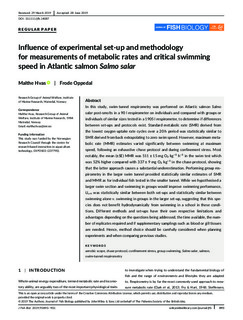| dc.description.abstract | In this study, swim‐tunnel respirometry was performed on Atlantic salmon Salmo salar post‐smolts in a 90 l respirometer on individuals and compared with groups or individuals of similar sizes tested in a 1905 l respirometer, to determine if differences between set‐ups and protocols exist. Standard metabolic rate (SMR) derived from the lowest oxygen uptake rate cycles over a 20 h period was statistically similar to SMR derived from back extrapolating to zero swim speed. However, maximum metabolic rate (MMR) estimates varied significantly between swimming at maximum speed, following an exhaustive chase protocol and during confinement stress. Most notably, the mean (±SE) MMR was 511 ± 15 mg O2 kg−1 h−1 in the swim test which was 52% higher compared with 337 ± 9 mg O2 kg−1 in the chase protocol, showing that the latter approach causes a substantial underestimation. Performing group respirometry in the larger swim tunnel provided statistically similar estimates of SMR and MMR as for individual fish tested in the smaller tunnel. While we hypothesised a larger swim section and swimming in groups would improve swimming performance, Ucrit was statistically similar between both set‐ups and statistically similar between swimming alone v. swimming in groups in the larger set‐up, suggesting that this species does not benefit hydrodynamically from swimming in a school in these conditions. Different methods and set‐ups have their own respective limitations and advantages depending on the questions being addressed, the time available, the number of replicates required and if supplementary samplings such as blood or gill tissues are needed. Hence, method choice should be carefully considered when planning experiments and when comparing previous studies. | nb_NO |
